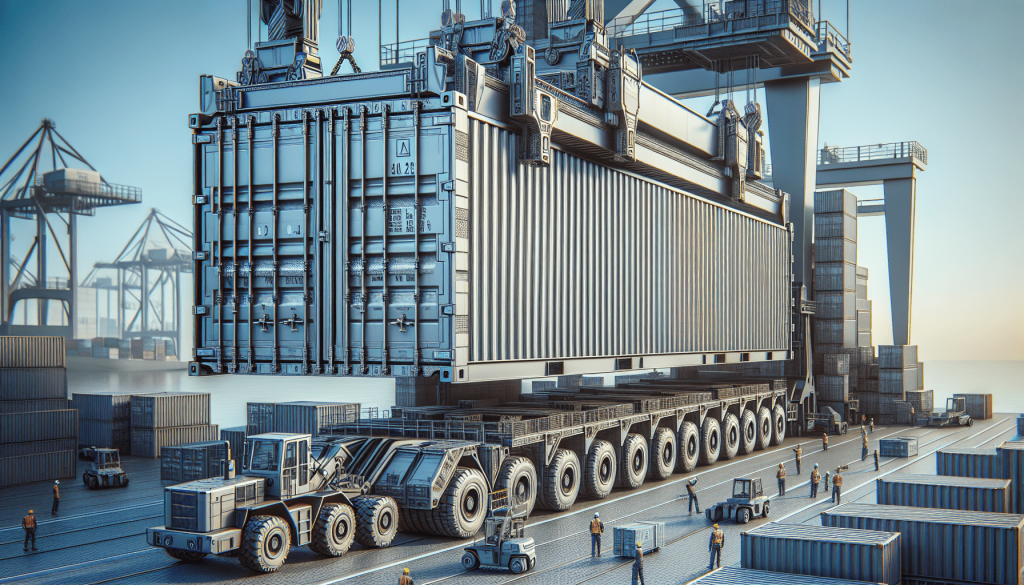Imagine you have just acquired a 40 foot container and now you’re faced with the daunting task of moving it. But fear not! In this article, we will explore the various methods and techniques available to help you successfully transport your 40 foot container to its destination. Whether you’re a seasoned professional or a first-time mover, we’ve got you covered with practical tips and expert advice to ensure a smooth and stress-free relocation for your container. So, roll up your sleeves and let’s get ready to tackle this challenge head-on!
Choosing the Right Transportation Method
When it comes to moving a 40-foot container, there are several considerations to keep in mind in order to ensure a smooth and successful transportation process. The first step is to choose the right transportation method that suits your needs and requirements. You have multiple options available, each with its own advantages and considerations.
Considerations for Transportation Method
Before making a decision on the transportation method for your 40-foot container, it is important to consider a few key factors. The distance of the transportation, the nature of the cargo, the cost involved, and the time frame you have for the transportation all play a crucial role in determining the most suitable method. Whether you opt for road transport, rail transport, sea freight, or a combination of these, it is essential to weigh the pros and cons of each option.
Options for Transporting a 40 Foot Container
There are different options available for transporting a 40-foot container. If your cargo needs to be moved over long distances, sea freight might be the most cost-effective option. Shipping companies have specialized vessels that can handle the transportation of containers, ensuring that your cargo reaches its destination safely and efficiently. Additionally, rail transport can be a viable option if you need to move the container over land. It offers a reliable and environmentally friendly alternative to road transport. However, if you require faster delivery or have a specific destination in mind, road transport could be the most suitable choice. It provides flexibility and convenience, allowing you to transport your container directly to your desired location.
Preparing the Container for Transport
Once you have decided on the transportation method for your 40-foot container, it is crucial to properly prepare the container for transport. This involves inspecting and securing the container to ensure the safety of both the cargo and the transportation process.
Inspecting the Container
Before loading your cargo onto the container, it is important to thoroughly inspect it for any damage or structural issues. Check for any signs of corrosion, leaks, or dents that could compromise the integrity of the container. Additionally, ensure that the container is clean and free from any debris or foreign objects. Conducting a comprehensive inspection will give you peace of mind knowing that your cargo is being transported in a safe and secure container.
Securing and Sealing the Container
Properly securing and sealing the container is another critical step in preparing it for transportation. Secure the container doors with heavy-duty locks to prevent any unauthorized access during transit. Additionally, consider using seals to indicate if the container has been tampered with. It is also important to ensure that the cargo inside the container is securely packed and properly braced to prevent any movement during transportation. This will help minimize the risk of damage and ensure that your cargo reaches its destination in optimal condition.

Arranging for Transportation Services
After preparing the container, the next step is to arrange for transportation services to ensure the smooth execution of the logistics process. This involves contacting shipping companies, obtaining quotes, and booking the transport service.
Contacting Shipping Companies
Start by reaching out to reputable shipping companies that specialize in container transport. Provide them with the necessary details, including the origin and destination of the container, the nature of the cargo, and any specific requirements you may have. This will allow the shipping companies to assess your needs and provide you with the most appropriate transportation options.
Obtaining Quotes and Comparing Costs
Obtaining quotes from different shipping companies is crucial to ensure that you are getting the best value for your transportation needs. Take the time to compare the costs and services offered by each company. Consider factors such as reliability, experience, and customer reviews to make an informed decision. Balancing cost with quality is essential to ensure a smooth and successful transportation process.
Booking the Transport Service
Once you have selected a shipping company and negotiated the terms, it is time to book the transport service. Provide the necessary details, such as the date and time of pick-up, as well as the expected delivery date and location. Confirm all the arrangements and discuss any specific requirements or instructions with the shipping company to avoid any misunderstandings or complications during the transportation process.
Coordinating Pick-Up and Delivery
Coordinating the pick-up and delivery of your 40-foot container is crucial to ensure a seamless and timely transportation process. Effective communication and providing accurate details are key in this step.
Providing Pick-Up and Delivery Details
When coordinating pick-up and delivery, provide precise information regarding the location of the container. Make sure to include any access restrictions or instructions that may be relevant for the transportation provider. If there are any specific time constraints, communicate these in advance to avoid any delays or conflicts.
Coordinating with the Shipping Company
Stay in contact with the shipping company throughout the process to ensure a smooth transfer of the container. Provide updates or any changes in pick-up or delivery details promptly. This will help the shipping company anticipate and address any potential challenges, ensuring a hassle-free and efficient transportation process.

Loading and Unloading the Container
The loading and unloading process plays a crucial role in ensuring the safety of your cargo during transportation. Depending on the nature and weight of the cargo, you may consider using heavy machinery or hiring professional loaders and unloaders.
Using Heavy Machinery
If the cargo is heavy or requires specialized equipment for loading and unloading, it is advisable to use heavy machinery. Cranes or forklifts can be employed to safely lift and position the container. This not only minimizes the risk of accidents or injuries but also ensures that the container is stabilized during transportation.
Hiring Professional Loaders and Unloaders
For efficient and safe loading and unloading, you may opt to hire professional loaders and unloaders who have the experience and expertise in handling containers. These professionals are trained to execute the process smoothly, minimizing the risk of damage to the container or its contents. Their knowledge of proper lifting techniques and cargo handling protocols ensures a secure and hassle-free transportation process.
Securing the Container During Transit
To ensure the container remains secure and stable during transit, it is crucial to apply twistlocks and lashings.
Applying Twistlocks and Lashing the Container
Twistlocks are devices that are used to secure containers to the chassis or other containers. They lock the containers in place, preventing any movement or shifting during transportation. Additionally, lashings, such as steel cables or chains, are used to further secure the container. These lashings limit any potential sway or movement, ensuring the container stays in place and reducing the risk of damage during transit.
Complying with Legal and Safety Requirements
Complying with legal and safety requirements is vital to avoid any legal issues and ensure the safety of your container and cargo.
Obtaining Permits and Clearances
Depending on the countries and jurisdictions involved in the transportation process, you may need to obtain permits and clearances. These documents ensure compliance with legal and safety regulations, allowing for the smooth passage of the container. Check with the relevant authorities or consult with your chosen shipping company to determine the necessary permits and clearances required for the transportation.
Ensuring Safety Measures are Followed
Safety measures should be followed throughout the transportation process to protect the container, the cargo, and the individuals involved. This includes adhering to weight restrictions, securing the container properly, and using appropriate safety equipment during loading, unloading, and transit. Conduct regular inspections and maintenance checks to ensure that the container remains in optimal condition and that any potential hazards or risks are minimized.
Tracking the Container’s Journey
Tracking the container’s journey is essential to ensure transparency and peace of mind throughout the transportation process.
Utilizing GPS Tracking Systems
GPS tracking systems allow you to monitor the container’s location in real-time. By utilizing these systems, you can track the progress of your cargo and stay updated on its estimated arrival time. This provides valuable information that allows you to coordinate with necessary parties and make any adjustments if needed.
Monitoring Shipping Updates
Stay in contact with the shipping company and monitor their updates regarding the status of your container. Regular communication helps address any concerns or potential issues that may arise during transit. Reacting promptly to any updates or notifications ensures that you are well-informed about the progress of your container’s journey.
Managing Customs and Documentation
Navigating through customs and ensuring all necessary documentation is in order is crucial to avoid any delays or complications in the transportation process.
Understanding Customs Regulations
Familiarize yourself with the customs regulations of the countries involved in the transportation process. Each country has its own specific requirements and procedures. Understanding these regulations in advance helps ensure compliance and facilitates the clearance process.
Preparing the Necessary Documents
Prepare all the necessary documents, including but not limited to, shipping labels, bills of lading, customs declarations, and any other required paperwork. Ensure that these documents are accurate, complete, and prepared in advance. This helps expedite the customs clearance process and avoids any unnecessary delays or penalties.
Clearing Customs
Upon arrival at the destination, the container will need to go through customs clearance procedures. Cooperate with the shipping company and customs officials to provide any additional documentation or information that may be required. By clearing customs promptly, you can prevent any unnecessary delays in delivering your cargo to its final destination.
Handling Unexpected Challenges
Despite careful planning and preparation, unexpected challenges may arise during the transportation process. Being prepared and proactive is key to addressing these challenges effectively.
Addressing Delays or Detours
Delays or unexpected detours can occur due to a variety of reasons, such as adverse weather conditions or unforeseen logistical issues. Stay in close communication with the shipping company and be flexible in finding alternative solutions. By promptly addressing any delays or detours, you can minimize the impact on the transportation process and ensure that your cargo reaches its destination as smoothly as possible.
Dealing with Container Damage
In rare cases, container damage may occur during transportation. If you notice any damage upon delivery, ensure to document it and report it to the shipping company immediately. Work closely with the shipping company to initiate the necessary steps to resolve the issue. Taking prompt action is crucial in ensuring that the responsibility for any damage is properly addressed and resolved.
Resolving Customs Issues
In case any customs issues arise, such as incorrect documentation or additional inspections, cooperate with customs officials and the shipping company to address and resolve these issues. Provide the necessary assistance or additional documentation as requested and remain patient throughout the process. Resolving customs issues promptly ensures that your cargo can proceed smoothly through the customs clearance process and reach its final destination without unnecessary delays.
Moving a 40-foot container may seem like a complex process, but with careful planning, preparation, and communication, it can be accomplished smoothly and efficiently. By considering the transportation method, preparing the container for transport, coordinating pick-up and delivery, loading and unloading with care, securing the container during transit, complying with legal and safety requirements, tracking the container’s journey, managing customs and documentation, and handling unexpected challenges, you can ensure the successful transport of your cargo.

I am James, the creator behind SeaBoxInnovations.com. Welcome to our premier online destination dedicated to the world of sea containers. Think Inside the Box is our tagline, and our website is your go-to source for exploring the endless potential of these versatile and adaptable containers. Whether you’re interested in purchasing, customizing, or learning about the latest trends in container architecture and design, we have you covered. Join us as we bridge the gap between traditional uses and cutting-edge applications, promoting sustainability and innovation in design and construction. Get ready to embark on your next big project with SeaBoxInnovations.com.

